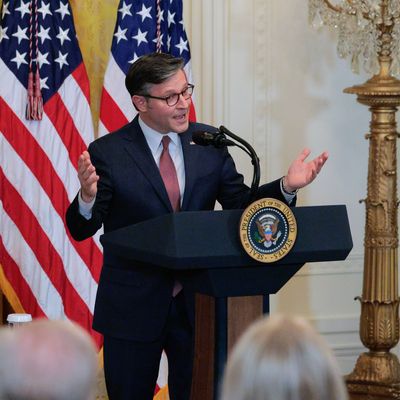

He’s going to dominate the midterms just like he dominates his party.
Photo: Chip Somodevilla/Getty Images
While presidents are always a dominant influence over the political parties they lead, that sway tends to fade toward the end of their tenures if they serve two terms. This is why they are typically called “lame ducks” at some point after being reelected. But Donald Trump is already well past the usual sell-by date because he has been his party’s presidential nominee three times. The prior politician with such an extended hold on a major party was Richard Nixon (nominated and defeated in 1960, elected in 1968, and reelected in 1972). Though Nixon won his last race in 1972 by a huge landslide, that didn’t turn out well for Republicans (Nixon resigned in 1974, and the GOP subsequently lost the White House).
At the moment, Trump seems to be defying the lame-duck precedent. No president has ever had a more dominant position in his own party, having crushed all intraparty dissent in his triumphant 2024 reelection campaign and then reduced the usually proud congressional leaders of the GOP to the status of loyal satraps. Whatever their private misgivings, all Republicans publicly sing his praises. And the most frequently uttered excuse for the major Republican underperformance in the off-year elections on November 4 was that Trump wasn’t on the ballot to bring those low-propensity voters who tilted his way in 2024 back to the polls.
The problem now, of course, is that Trump won’t be on the ballot in the 2026 midterm elections, either. So if the key to victory is to turn out every single pro-Trump voter, that would mean making the midterms even more of a referendum on the incumbent president than it will be in any case. That would certainly be Trump’s preference, of course; the Sun King always believes he is the source of all radiance. Unfortunately, as his steadily eroding job-approval ratings show, his agenda is not very popular. And when it comes to his administration’s greatest weakness, a perceived inability to reduce living costs, his current prescription seems to be to claim things are better than they appear, as the Associated Press reports:
President Donald Trump took a victory lap on the economy on the one-year anniversary of his successful election, boasting of cheaper prices and saying the U.S. is the envy of the globe even while the Republican Party faced a rebuke from voters anxious about their own finances in Tuesday’s off-year elections.
Trump, speaking Wednesday at the America Business Forum, said he thinks that communication was the problem, insisting that “we have the greatest economy right now” and that “a lot of people don’t see that.”
“These are the things you have to talk about,” Trump told a packed arena at Miami’s Kaseya Center that included top business executives, global athletes and political leaders. “If people don’t talk about them, then you can do not so well in elections.”
This, too, was the economic-messaging strategy of Joe Biden for much of his term in office, and it rather clearly did not work. It’s true that owning the status quo and treating it as threatened by the nefarious opposition is a way to mobilize already-loyal base voters. But it’s a bad idea if swing voters aren’t happy, and they definitely aren’t happy now. So looking ahead to the midterms, Republicans have a classic base voter–swing voter dilemma that won’t resolve itself.
Perhaps swing-voter-sensitive Republicans can convince their leader to modify his policies and priorities to make them more generally popular. But Trump is not exactly renowned for taking advice, particularly if that means admitting error. And for his entire career, he has pursued a base-in, rather than a center-out, political strategy, counting on polarization to put him in a position to win with superior voter mobilization and the mistakes of his opponents.
If Republicans decide on yet another MAGA messaging extravaganza with Trump at the center as always, then the one thing we know for sure is that the GOP’s persuasion strategy for swing voters will be strictly negative. If you cannot occupy the political center, you try to push the other party out of the center by regular assertion that it is extremist. Trump is without question a master of this tactic, and we’re already seeing him warming up for 2026 by calling Zohran Mamdani a communist and treating the entire “radical left” Democratic Party as beyond the pale. One question Republicans will have to answer, however, is whether key elements of the electorate will get tired of polarization theater and finger their president as the main perpetrator. Any way you slice it, though, he will not get out of the spotlight until his political career has ended, if then. And that’s a problem for the GOP.
Source link






